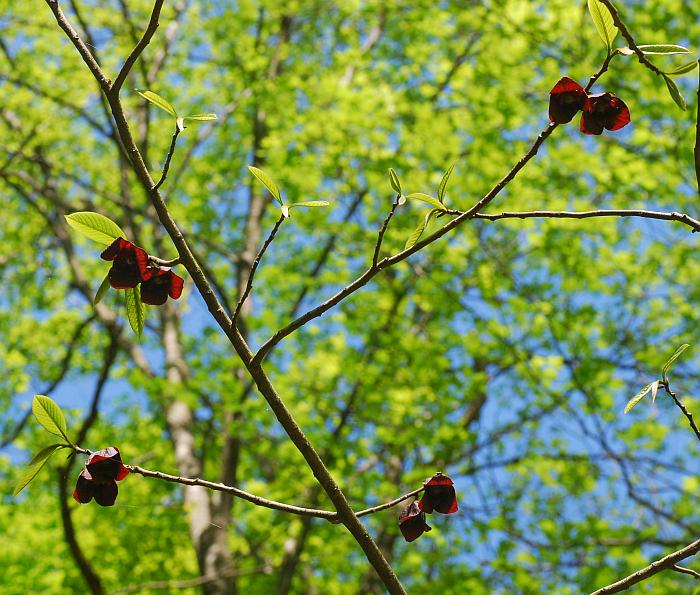Asimina triloba (L.) Dunal
Pawpaw

Native
CC = 5
CW = 0
MOC = 78
© SRTurner
Asimina triloba (L.) DunalPawpaw | |
 |
Native CC = 5 CW = 0 MOC = 78 |
© SRTurner |
|
Family - Annonaceae Habit - Small trees, usually strongly colonial from root suckers. Stems - To 10 m. Bark gray, usually with white to light gray patches, thin, smooth, becoming roughened (warty) or rarely scaly on older trees. Twigs light to dark reddish brown, glabrous or sparsely hairy, the buds lacking scales, reddish brown, hairy, the terminal bud flattened and narrowly ovate in outline, the lateral buds nearly globose.
Leaves - Alternate, simple, petiolate. Petiole 5-20 mm long. Stipules absent. Blades 10-35 cm long, oblanceolate to oblong-obovate, narrowed or tapered at the base, abruptly tapered to a short point at the tip, glabrous at maturity (hairy when very young), the veins prominent, the margins entire, the upper surface green and usually shiny, the undersurface pale green.
Inflorescence - Flowers solitary at the nodes of the second year's growth along branches, produced before or as the leaves develop. Flowers - Perfect, hypogynous, on short, hairy stalks. Sepals 3, 8-12 mm long, broadly triangular, sharply pointed, green, usually hairy, shed early. Petals in two unequal and strongly overlapping whorls of 3, the outer series 2.1-2.7 cm long, broadly ovate, the tips spreading and curled outward, the inner series 1.0-1.4 cm long, ovate, erect or with the tips somewhat spreading, the surface of both series with prominent veins, red-brown to maroon at maturity (green when immature), hairy on the outer (under) surface, the inner series with nectar-producing glands at the base of the inner surface. Stamens numerous, small, free, densely packed around the elongated receptacle, not clearly differentiated into an anther and filament. Pistils 3-5, hairy, with 1 carpel, the ovary superior and with 12-16 ovules, the style short, the stigma globose.
Fruits - Berries, single or 2-4 in a spreading or drooping cluster, 4-13 cm long, ellipsoid to cylindrical, somewhat irregular, rounded at the ends, pale green, turning yellowish and then brownish black with age. Seeds 2-10, 2.0-2.8 cm long, flattened, elliptic-ovate in outline, dark brown, shiny, embedded in a light yellow edible pulp.
Flowering - March - May. Habitat - Understory tree in bottomland and mesic forests, along streams, ravines, base of bluffs. Origin - Native to the U.S. Lookalikes - None when in flower. Other info. - This common tree can be found throughout most of Missouri, and most of eastern half of the continental U.S. as well as Canada. The tree is recognized by its strongly colonial habit, smooth gray bark, and large leaves which are broadest above the midpoint. The deep maroon flowers are also unique. Photographs taken at the Kansas City Zoo, 5-1-00, in Brown Summit, NC., 3-23-03, and at Whetstone Conservation Area, Callaway County, MO., 2-25-04 (DETenaglia); also at Engelmann Woods Natural Area, Franklin County, MO, 4-12-2010, Glassberg Conservation Area, Jefferson County, MO, 5-9-2013, and along the Meramec River near Glencoe, St. Louis County, MO, 7-17-2017 (SRTurner). |